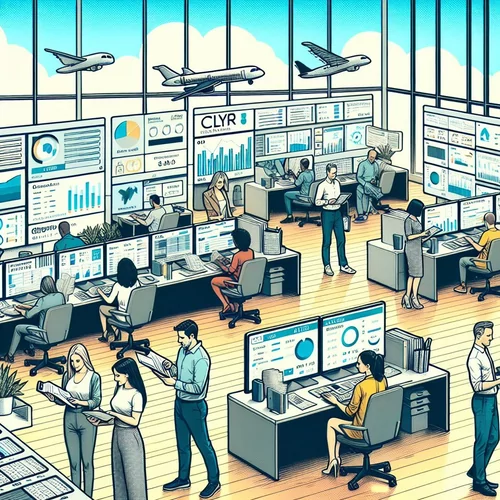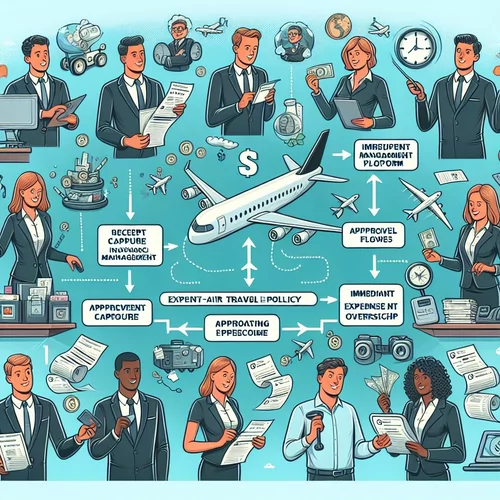If you are an employee embarking on a business trip, navigating the rules and regulations can often feel overwhelming. But fear not! With this all-encompassing guide by your side, you can confidently navigate the complexities of optimizing your air travel policy for employees while adhering to regulations. Armed with the extensive knowledge presented in this manual, you will have the essential expertise to confidently navigate the heavens, guaranteeing complete adherence to your company’s aviation protocols.
Decoding Air Travel Policies: A Primer for Employees
Navigating through a company’s air travel policy can often feel like unraveling a complex puzzle in today’s corporate landscape. However, fear not, as we are here to decipher this enigma for you. Gain a complete understanding of your company’s air travel policy, from the basic elements of reservation to the complex intricacies of non-compliance, as we present you with a comprehensive guide to navigating and mastering this framework.
Let’s break it down:
- Understand the ABCs of your company’s travel guidelines.
- Grasp the consequences of straying from the policy path.
- Discover how to make the most of your travel within policy parameters.
With this knowledge, you’ll be equipped to travel smart and stay compliant.
Unraveling the Types of Air Travel Policies
Companies craft air travel policies ranging from simple to intricate. Some offer a set of basic guidelines, while others present detailed protocols. Let’s explore:
- Basic Guidelines: These are the ground rules, the do’s and don’ts of corporate travel. Think of them as the travel policy’s skeleton.
- Detailed Protocols: Here’s where things get granular. These policies cover everything from flight booking to hotel check-out, leaving no suitcase unturned.
Understanding the type of policy your company employs is the first step to seamless travel.
Basic Guidelines: The Foundation of Air Travel Policy
It is essential for every employee to have a thorough understanding of their company’s air travel policy guidelines. These guidelines are of utmost importance and must be strictly adhered to during business trips. Generally, they encompass the following aspects:
- Booking flights through approved channels.
- Adhering to baggage allowances.
- Submitting expense reports promptly.
These guidelines are your travel policy bedrock, ensuring you’re on solid ground from takeoff to touchdown.



Detailed Protocols: The In-Depth Itinerary
If you are someone who appreciates precision and attention to detail, a travel policy that is constructed based on meticulous protocols can offer the necessary framework and direction. By providing comprehensive instructions, these protocols guarantee that you will be equipped with thorough guidelines for each phase of your journey. Anticipate receiving direction on:
- Booking flights with preferred airlines.
- Arranging ground transportation.
- Managing travel expenses with precision.
Adhering to these protocols means your business travel will be as smooth as a first-class seat recline.
Compliance: The High Stakes of Air Travel Policy
Compliance isn’t just a buzzword; it’s a business imperative. Ignoring your company’s air travel policy can lead to:
- Financial fallout from non-reimbursable expenses.
- Legal entanglements if industry regulations are flouted.
- Reputational risks that can tarnish your professional image.
By adhering to the guidelines set forth in the policy, you can steer clear of the disruptive consequences that come with turbulence.
Behind the Scenes: Crafting Air Travel Policies
What influences the creation of air travel policies? It’s a blend of:
- Budget Constraints: Balancing cost with comfort is an art form in policy creation.
- Corporate Culture: Some companies splurge on business class, while others stick to economy.
- Legal Requirements: Duty of care and visa regulations shape policies to ensure legal compliance.
These factors are the architects of your company’s air travel policy.



Optimizing Travel Within Policy Limits
Even within the confines of air travel policies, there’s room to optimize your experience. Here’s how:
- Scout for flight deals within approved channels.
- Use layovers to power through work or explore.
- Plan ahead to enjoy your destination’s offerings.
With these strategies, you can elevate your travel experience without overstepping policy boundaries.
Enjoy Business Trips Without Breaking The Bank
Here are some tips to keep your journeys stress-free:
- Join airline loyalty programs for perks.
- Pack smart to breeze through security.
- Embrace tech to stay productive on the go.
- Stay hydrated and rested to combat jet lag.
Become a master of travel policies by following these tips, and you’ll effortlessly navigate the skies with finesse.
While embarking on your business travels around the world, keep in mind that Clyr is here to support you in effortlessly managing your travel expenses. Our platform is designed with the main goal of simplifying the expense management process, seamlessly integrating with your existing cards and accounts. With Clyr, rest assured that your expenses will be expertly handled, leaving you free to focus on the exciting journey that lies ahead.
The Role of Technology in Modern Travel Policy Compliance
Embracing the advancements of technology is crucial in today’s era, especially when it comes to implementing efficient expense management solutions. These solutions play a vital role in ensuring compliance with policies. Now, let’s delve into how technology can serve as your reliable co-pilot in this aspect:
- Tools like Clyr streamline the expense reporting process, reducing errors and ensuring timely submissions.
- Receive instant notifications for policy breaches or overspending.
- Say goodbye to paper clutter with apps that capture and categorize receipts on the go. By embracing real-time expense tracking software, you can maintain compliance effortlessly, even when jet-lagged.



Balancing Safety and Efficiency in Air Travel Policies Safety
When it comes to formulating a meticulously designed policy for air travel, it is imperative to maintain a delicate balance between efficiency and the integrity of your content, ensuring that both aspects can seamlessly coexist. Here’s how to strike the balance. Ensure your policy includes a list of vetted airlines with strong safety records. Have clear procedures for emergencies, including medical issues or geopolitical unrest. To ensure minimal travel time and avoid any potential delays or missed connections, it is advisable to choose direct flights whenever they are available. By placing importance on safety while also considering efficiency, employees can confidently travel with a sense of tranquility.
The Environmental Impact of Business Travel and Sustainable Policies
In light of the increasing worldwide consciousness regarding the environment, many organizations are currently placing emphasis on assessing the ecological consequences of their travel procedures. Below, you will find several strategies for integrating sustainability into your air travel policies: Consider supporting initiatives that aim to offset the carbon emissions generated by air travel. Choose airlines and hotels that prioritize environmental conservation. Promote the use of video conferencing as a feasible alternative to unnecessary travel. By embracing sustainable practices, businesses can actively contribute to the global initiative of reducing environmental damage.
Crafting a Personalized Travel Policy: A Guide for Managers Creating
To effectively manage business travel, it is crucial for managers to create a personalized travel policy that caters to the specific needs of their company. Here is a detailed, step-by-step guide to help managers craft a tailored travel policy.
- Evaluate the nature of your business travel, considering factors like frequency, destinations, and employee roles.
- Establish what you want to achieve with your policy, such as cost savings, safety, or employee satisfaction.
- To gather a wide range of perspectives, it is important to engage various stakeholders such as finance, HR, and individuals who frequently travel. Additionally, exploring industry benchmarks and considering alternative solutions to Concur can provide valuable insights into effective practices employed by others.
- Allow for some leeway to accommodate unexpected changes or personal preferences within reason.
- Utilize efficient expense management automation solutions to streamline processes and enforce policy compliance.
- Ensure that all employees understand the policy and its benefits to encourage adherence. By following these steps, managers can create a travel policy that is both effective and adaptable to the company’s evolving needs.
The Future of Business Travel: Trends and Predictions
As time goes by, the landscape of corporate travel is constantly evolving. In the following section, we will explore different trends and predictions that are shaping the future. A notable pattern that stands out is the growing inclination towards blending business trips with leisure excursions, where employees extend their stays to indulge in personal leisure activities. In order to minimize their impact on the environment, more and more companies are embracing eco-friendly travel policies. The adoption of real-time expense tracking software and mobile applications is on the rise, contributing to enhanced travel efficiency. Travel experiences will become more customized, with policies allowing for individual preferences within set guidelines. Advances in virtual meeting technology may reduce the need for travel, but face-to-face interactions will remain valuable. These trends indicate a future where business travel is more personalized, integrated with technology, and environmentally conscious.



The Intersection of Personal and Business Travel:
Understanding the Boundaries Combining business and personal travel can be beneficial, but it’s important to understand the boundaries. Here’s how to navigate the intersection. Ensure your travel policy clearly defines what is considered personal versus business travel. Use efficient expense management solutions to keep personal and business expenses distinct. Discuss plans with management to align on expectations and avoid misunderstandings. Adhere to tax implications and company rules when extending business travel for personal reasons. By respecting these boundaries, employees can enjoy the perks of bleisure travel without compromising policy compliance.
Case Studies: Companies Excelling in Travel Policy Management Several
Companies stand out for their innovative and effective travel policy management. Here are a few case studies. A leading tech company revised its policy to allow employees to book through any channel, as long as they stay within budget and use the company’s automated financial reporting for out-of-office teams. A global consulting firm implemented a comprehensive safety program, including pre-travel health checks and real-time risk monitoring. By prioritizing flexibility, safety, and sustainability, a policy introduced by a small to medium-sized enterprise encourages train travel over flights and implements a carbon offset program. The following instances demonstrate companies’ successful implementation of travel policies aimed at minimizing their ecological footprint, thus emphasizing their dedication to environmental sustainability.
The Takeaway for Today’s Corporate Traveler
For contemporary business travelers, effectively managing air travel policies involves finding the right equilibrium between corporate requirements and personal choices. Workers can make wise and productive choices on their journeys by staying informed, harnessing technological advancements, and recognizing the limitations of policies. It is crucial to bear in mind that tools such as Clyr are extremely useful in overseeing travel expenditures and guaranteeing adherence to regulations. With the appropriate strategies and tools at hand, corporate travel can be an effortless and fulfilling endeavor for everyone concerned.